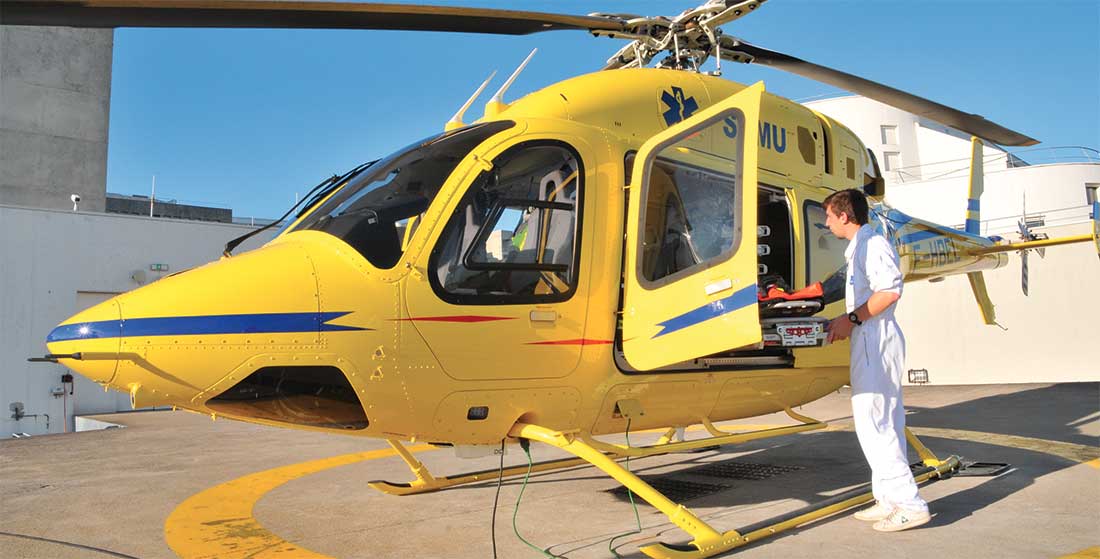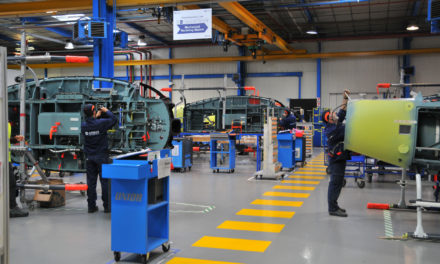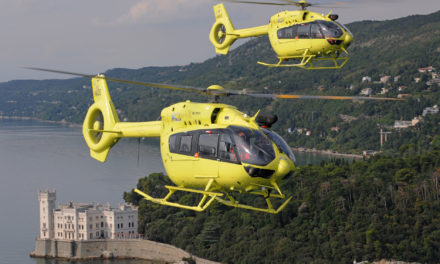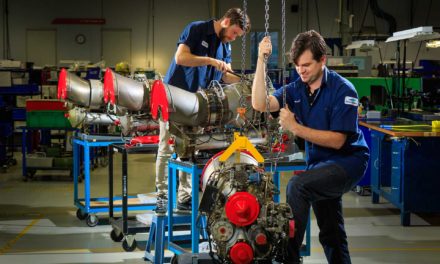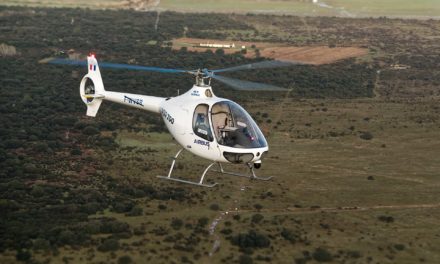By François Blanc
Copyright: F.Blanc
Despite initially dragging their feet, French air ambulances have now integrated a second technical crew member into their teams, in compliance with EU regulations. However, the role of these new “flight assistants” remains vague. Perhaps not for long…
AS THEY DO EVERY YEAR, MEMBERS OF THE FRENCH ASSOCIATION OF MEDICALIZED HELICOPTER USERS (AFHSH) GATHERED FOR THE ASSOCIATION’S ANNUAL MEETING IN MARCH 2017. UNDER THE WATCHFUL EYE OF THEIR NEW PRESIDENT, DR. CHRISTOPHE BOYER, HEAD OF EMERGENCY MEDICAL SERVICES (EMS) AT UNIVERSITY HOSPITAL IN LILLE, MEMBERS ONCE AGAIN DEBATED—AMONG OTHER THINGS—THE LEGITIMACY OF ADDING A NEW TECHNICAL CREW MEMBER (TCM, MORE READILY REFERRED TO AS THE “FLIGHT ASSISTANT”) TO SUPPORT PILOTS DURING MISSIONS. IN THE MONTHS LEADING UP TO THE YEARLY GATHERING, WORKING GROUPS HAD ALREADY CONDUCTED BRAINSTORMING SESSIONS ON QUESTIONS THAT MAY SEEM MORE TRIVIAL, BUT THAT ARE JUST AS REVELATORY OF THE DIFFICULTIES FRENCH EMERGENCY MEDICAL PROFESSIONALS ARE FACED WITH WHEN THEY TRY TO UNIFY PRACTICES AND ESTABLISH A CODIFIED IDENTITY FOR AIR AMBULANCE HELICOPTERS. FOR EXAMPLE, “ONE GROUP WORKED ON WAYS OUR ON-BOARD MEDICAL EQUIPMENT COULD BE DESIGNED AND INSTALLED IN THE FUTURE. ANOTHER GROUP FOCUSED ON HOW WE SHOULD PAINT OUR AIRCRAFT TO MAKE IT EASIER FOR THE PUBLIC TO IDENTIFY THEM AND HELP PEOPLE BETTER UNDERSTAND WHAT WE DO,” EXPLAINED CHRISTOPHE BOYER. THE GOAL OF THE CONFERENCE WAS TWOFOLD: “IT’S BETTER FOR US, AS PROFESSIONALS WHO WORK WITH HELICOPTERS, TO FIND A WAY TO MAKE THE AUTHORITIES— THE MINISTRIES OF HEALTH AND TRANSPORTATION—UNDERSTAND OUR NEEDS. WE HAVE TO ANTICIPATE FUTURE CHANGES, RATHER THAN HAVE SOLUTIONS THAT DON’T WORK FOR US IMPOSED ON US. BECAUSE, NO MATTER WHAT, OUR PROFESSIONS AND MISSIONS ARE SUBJECT TO BUDGETARY CONSIDERATIONS. WE MIGHT AS WELL MAKE SURE WE PLAY A ROLE IN OUTLINING THE SYSTEMS BEING DEVELOPED TO SAVE MONEY.”
MATERIAL AND PRACTICAL CHANGES
Insignificant questions? Hardly. Particularly the issue of internal layout. “The degree of user-friendliness found in the air ambulances of tomorrow correlates directly to our medical effectiveness, but will also have a significant impact on the calls for tender that dictate which helicopter operators are granted which contracts in the French system,” continued the head of EMS at University Hospital in Lille, explaining in addition that as new changes are made to the medical equipment on board, practices themselves evolve. “Cardiopulmonary bypass equipment, for example, has improved greatly over the years. Today we can transport patients whose hearts are not beating, while their blood circulates and is oxygenated by a small machine,” he confided, before concluding, “The era when medical teams put their equipment where they could in the helicopter and went on their missions without a second thought is over.” The other topic on the agenda—flight assistants—lead to fruitful exchanges between attendees. As you may remember (see Helicopter Magazine Europe No. 68), when the new European Air-OPS regulation went into effect, French helicopter operators requested that the French authorities postpone enforcing it for as long as possible under the provisions of the law. Since then, operators have had to comply. However, as the President of the AFHSH explained, “We are still not all in agreement about the ideal profile for this second technical crew member.”
A FALSE START
In other words, during the years spent postponing the enforcement of the EU regulation, French players were unable to clearly outline the role to be played by the second technical crew member. Why? “Things got off on the wrong foot,” Boyer summarized. Indeed, from the outset, teams involved in air ambulance missions were displeased with the obligation to bring aboard another crew member—which represents 80 kg of additional weight on average—because it would diminish aircraft autonomy. The discussion got stuck on this point, and “the opponents never came up with any solutions to overcome the problem.” This led to a lack of preparation, which in turn caused operators to hire staff “with very different backgrounds” and provide them with a “summary” training. Adding fuel to the fire, certain pilots claimed they did not need help from a second crew member. Last but not least, EMS directors also expressed skepticism about the importance of adding an assistant whose medical role was not at all clear
And for good reason: for legislators, the flight assistant is squarely defined as a technical crew member, wholly concerned with flying the aircraft. “At the time, we were totally incapable of seeing the presence of a flight assistant in our helicopters in a positive light,” Boyer admitted. At the same time, several operators who work both in France and in neighboring countries quickly added the new flight assistant to their teams. “In Lille, we had a bit of perspective on the issue since our service provider, Belgian company NHV, had been working with two-man teams for quite some time. When we first started working with a flight assistant, we didn’t immediately recognize the potential benefits, but we figured it out fast! Particularly because they were well trained crew members who worked well with the pilots. We never ran into a single problem. In fact, the flight assistants ended up being a help for the medical teams as well.”
THE DEBATE CONTINUES
It seems, for Boyer, that most of the reservations are due to “insufficient preparation for the teams integrating the second crew member.” His outlook, overall, is hopeful: “It will undoubtedly take a few years for the flight assistant position to become clearly defined and for its usefulness to be fully recognized.” Despite this optimism, there is still one sticking point: Does the flight assistant work for the helicopter operator, like the pilot, or for the hospital? The debate continues, with two opposing viewpoints. “Hospitals are constantly dealing with budgetary constraints. If the second technical crew member is the hospital’s financial responsibility, the position is no longer included in the calls for tender for helicopter operators. Moreover, since a medical team is made up of three people—a doctor, a nurse and an EMT— one wonders what happens to the EMT when the other two board the helicopter. Which is why the idea of having the EMT serve as the flight assistant is far from ludicrous. My personal view on the issue, however, is one person, one job. Some would argue that an EMT can do two different jobs, working as an EMT one day and a technical crew member the next. But I’m not sure you can ask a person to have outstanding skills in two different professions, based in two different worlds. In my opinion, a flight assistant is an aviation professional working a special mission, while an EMT is a medical professional dedicated to healthcare.” The question remains unanswered, but Dr. Boyer expects the issue will finally be settled in the near future by the French Ministry of Health’s Healthcare Offerings Directorate (DGOS). One thing is sure: future calls for tender for helicopters to be used as air ambulances in France will require aircraft able to carry “five people as far and as fast as possible,” concluded the EMS specialist.
Airbus Helicopters leads global EMS market
With the delivery of three H135s to French operator SAF Hélicoptères last May, European manufacturer Airbus Helicopters has reclaimed its position as the leading
supplier of air ambulance helicopters worldwide. Olivier Michalon, Senior Vice President and Head of Sales in Europe, explained that, “with its spacious, modular
cabin designed to facilitate in-flight patient treatment and the lowest direct maintenance costs in its category, the H135 is the benchmark for emergency medical services.”
Airbus Helicopters has approximately 1,200 aircraft in service in the sector, making it the global leader.
SAF Hélicoptères currently has 40 of the brand’s helicopters in its fleet, including 27 from the EC/H135 family. The three new helicopters boast several technical
advances over previous generations, including longer blades, modified air intake, updated FADEC and new features in the cockpit.

